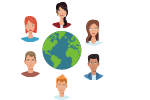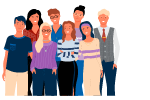The Interview | Luis Pizarro
 |
How would you present your organization in a few words? What entails your position? What is your goal? |
The Drugs for Neglected Diseases initiative (DNDi) is a not-for-profit medical research organization that discovers, develops, and delivers treatments for neglected populations.
We were founded in 2003 by Médecins Sans Frontières (MSF) together with medical research institutions in Brazil, India, Kenya, Malaysia, and France, and the World Health Organization (WHO), in response to the frustration of clinicians who were faced with medicines that were ineffective, unsafe, unavailable – or that had never been developed at all. Since our creation, we have delivered twelve new treatments for diseases such as leishmaniasis, sleeping sickness, and malaria, saving millions of lives.
For example, 20 years ago, sleeping sickness could only be cured with injections of an arsenic derivative so toxic that it killed 5% of patients. Now, it can be treated with simple pills, and we are working with our partners to develop an even better medicine with the potential to help sustainably eliminate this dreaded disease. We have offices in Nairobi, Rio, Kuala Lumpur, New Delhi, Kinshasa, Cape Town, Tokyo, and New York, with half of our staff based outside of Geneva.
I became the executive director of DNDi last year. My responsibilities include setting our strategic vision and goals, overseeing our research and development (R&D) programmes, ensuring these programmes are conducted according to the highest scientific and ethical standards. I am also responsible for supporting our advocacy efforts and representing our organization to external stakeholders, such as partners, funders, and policy makers.
My first goal is to support our strategic plan to develop 25 treatments in our first 25 years. We have a strong pipeline of new treatments for neglected diseases, and my first task is to keep this pipeline going. I also want to foster South-South research collaborations, contribute to more gender-responsive R&D, and advocate to change the pharmaceutical R&D system to make it more equitable and inclusive.
We have a lot to do!
 |
Among the concentration of actors in Geneva (IOs, NGOs, permanent missions, academia, and the private sector), who do you work with and how? |
We work with more than 200 partners, from international Geneva and across the globe, to deliver safe, effective, affordable, and accessible drugs.
Our partners include NGOs such as Médecins Sans Frontières; national health authorities and health institutions in endemic countries who are at the frontlines of the control efforts against neglected diseases; international organizations such as WHO; universities, laboratories, and public research institutions; public and private donors; and industrial partners, including global pharmaceutical companies that historically had little interest in neglected diseases.
We act as a conductor of a virtual orchestra, bringing together and coordinating all these diverse players, without which we would be unable to deliver the drugs patients urgently need. Partnerships are at the core of what we do. This model works: our collective achievements demonstrate that an alternative model for drug development, focused on patients’ needs and not profits, is viable.
 |
What are the strengths and weaknesses of Geneva with regards to the development of your activity? |
Geneva is a capital of global health. As part of our advocacy work, we engage with the permanent missions and attend key policy meetings at the UN and other institutions.
The city also hosts most of the major global health actors, so we find ourselves amongst a myriad of organizations such as Unitaid, MMV, FIND, the Global Fund, UNAIDS, MSF, GAVI, WHO, and so many others.
This concentration can contribute to better coordination of efforts to tackle global health challenges, finding partners, and facilitating discussion and action.
I should also point out the fantastic support of the Republique et canton de Genève, which has been funding DNDi’s research programmes on mycetoma, a debilitating infection that is one of the most neglected diseases. As we mark World NTD Day today, I would like to express our gratitude.
A possible weakness of such a concentration of global health actors is the risk of ‘group think’, a lack of diversity, and a remoteness from the communities most affected, which can lead to top-down, one-size-fits-all approaches to public health that are not necessarily adapted to all parts of the world. It is important to have a stronger connection with national and regional organizations, particularly from the Global South.
Organizations in Geneva have a crucial role to play in ensuring that all stakeholders are enabled to participate and exchange alternative ideas, practices, and perspectives from across the world that can help to improve health outcomes, particularly for neglected populations.
 |
What do you think global health governance should look like 20 or 30 years from now? |
We need to design a system of global health governance that ensures equitable access to life-saving health tools.
For example, we need to reimagine the way R&D is conducted and governed in the public interest. Decisions are made throughout the R&D process that impact whether health products will be available, affordable or accessible. Governments have a key role to play here, including by using public funding wisely by attaching conditions that ensure sharing of knowledge and equitable access to new treatments.
But as global health governance is shaped by global governance, it suffers from the same pitfalls. The failed global response to the COVID-19 pandemic, which has brought to the fore widespread and systemic inequalities, is a concrete illustration of the impact of these shortfalls.
Global health governance must have equity as its goal. To reach it, we need to question what decisions are made, and just as importantly, who gets to make them. It cannot be a small group of countries or funders.
With renewed public leadership and new models of international cooperation focused on these goals, it will be possible to achieve not only continued innovation to meet ever growing needs, but also equitable access to the fruits of scientific progress for all people, no matter their income or where they live.
 |
What question would you like to have been asked? And what keeps you “awake at night”? |
Among the many challenges that continue to exert a disproportionate burden on the most vulnerable people on our planet, climate change and its impact on global health are particularly alarming.
The number of people at risk of dengue, for example, is predicted to reach 60% of the world’s population by 2080 as a result of climate change, rapid urbanization, and population growth. And yet, there is no specific treatment available for the disease.
Rising temperatures will impact the vectors that carry diseases (such as mosquitoes for dengue, or sandflies for leishmaniasis) and lead to increased biting frequency, longer transmission seasons, and vectors spreading to new areas with currently low transmission. Many infectious diseases, including neglected ones, will be affected.
We cannot repeat the mistakes of the global COVID-19 response, and we must ensure that life-saving medical innovation will be available to everyone. Without changes to the public policies shaping the R&D ecosystem, innovation will remain the privilege of the rich, while populations in already burdened countries in the Global South will be the hardest hit by climate-sensitive diseases.
The world needs to be prepared. So far, it is not.
